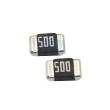There are various volume specifications for alloy resistors, and common packaging sizes include 2512, 2010, 1206, 0805, 0603, etc. These sizes correspond to different power levels, such as 0.25W, 0.5W, 0.75W, 1W, 2W, 3W, 4W, 5W, 10W, etc. In addition, there are some larger volume specifications such as 3637 (9.4mm × 9.2mm), 2818 (7.1mm × 4.6mm), 2816 (7.1mm × 4.2mm), 3720 (3.7mm × 2.0mm), etc., which are usually used in situations that require higher power and lower resistance.

The volume selection of alloy resistors mainly depends on the application scenario and circuit design requirements. Smaller package sizes such as 0603 and 0805 are suitable for circuit boards with limited space, while larger packages such as 2512 and 3637 can provide higher power processing capabilities. Meanwhile, the material of alloy resistors, such as manganese copper ceramic alloy, iron chromium aluminum alloy, nickel copper alloy, etc., also affects their performance and application range.
In terms of fuse safety regulations, the design of alloy resistors also needs to consider overcurrent protection and melting characteristics to ensure the safe operation of the circuit. Some alloy resistor products have also passed relevant safety certification to meet the safety requirements of different industries and application scenarios.
In short, there are various volume specifications for alloy resistors, and the selection needs to be comprehensively considered based on specific application scenarios and circuit design requirements. At the same time, paying attention to the safety requirements of fuses and selecting products with appropriate overcurrent protection and melting characteristics is also an important step in ensuring the safe operation of circuits.
